Please Take Note: This is a review of the final game, but it might change slightly based on the Kickstarter campaign’s success. The game is being reviewed on the components and the rules provided with the understanding that “what you see is not what you might get” when the game is published. If you like what you read and want to learn more, we encourage you to visit the game’s website. Now that we have all that disclaimer junk out of the way, on with the review.

The Basics:
- For ages 10 and up (publisher suggests 14+)
- For 2 to 6 players
- Approximately 30 minutes to complete
Geek Skills:
- Active Listening & Communication
- Counting & Math
- Logical & Critical Decision Making
- Reading
- Strategy & Tactics
- Risk vs. Reward
- Hand/Resource Management
Learning Curve:
- Child – Easy
- Adult – Easy
Theme & Narrative:
- Enter the gauntlet to prove your hero’s worth by not parishing!
Endorsements:
- Gamer Geek rejected!
- Parent Geek approved!
- Child Geek approved!
Overview
Being a hero means you risk it all, for there is a treasure to be won, fame to be earned, and a legend to build! The life of a hero is short and bright, as a result. So sad that many a hero has breathed their last in the darkness of dungeons or crypts. Regardless of the warnings and obvious threats, you grab your equipment and venture forth with a group you don’t entirely trust. Danger and adventure await! And death… Lots of death.
RPG Battles: The Card Game, designed by David Eldred and to be published by Sine Cera Marketing, will reportedly be comprised of six large Character cards, 90 cards (that contains monsters, traps, encounters, actions, and weapons), 2 standard 20-sided dice, a 20 Health tokens. As this is a prepbulished game, I cannot comment on the game component quality or artwork.
Meeting at the Inn
To set up the game, first allow each player to select a character of their choice. Any Character cards not used are returned to the game box. Players take their selected Character card and place it in front of them. Give each player three Health tokens at this time, as well.
Second, from the deck of cards, remove all Special Ability, Monsters, Traps, Teleports, and Daggers. Place these aside for the moment.
Third, give each player their Special Ability card that matches their selected Character card. These are placed in front of the player and face-up next to their Character card. Place any unused Special Ability cards back in the game box.
Fourth, shuffle the remaining cards and deal four to each player, face-down. These cards are the player’s starting hand. Cards in a player’s hand should remain hidden until played to the table.
Fifth, give each player one Teleport and one Dagger card. Players immediately “equip” the Dagger card by placing it face-up in front of them and next to their Character card, connecting it to the “Weapon” slot. The Teleport card goes into the player’s hand.
Sixth, take the removed Monster and Trap cards and any remaining Teleport cards, shuffling them back into the deck. Place the deck face-down in the middle of the playing area. This is the draw deck for the duration of the game. Leave room for a discard pile. Place any remaining Dagger cards back into the game box.
That’s it for the game set up. Have each player roll a 20-sided die to determine initiative.
Introduce Your Character
Each player’s Character card has a slot for Armor and Weapon cards. Armor will change the player’s base Armor Class, and Weapons will improve the player’s odds of hitting a target. All players start with no armor and a simple dagger. Upgrades are possible during the game.
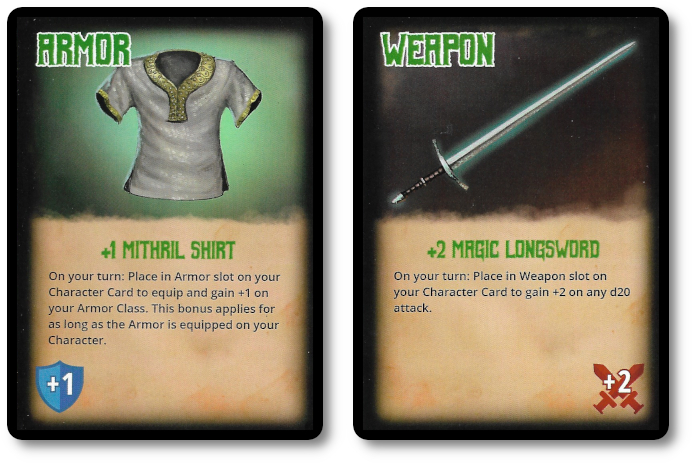
Equipping and unequipping either armor or weapons requires the player to replace what is currently played with a new card in their hand. This can only be done once per turn, and any cards replaced may be brought back into the player’s hand or discarded. A player must always have a Weapon card in play but is free not to wear armor.
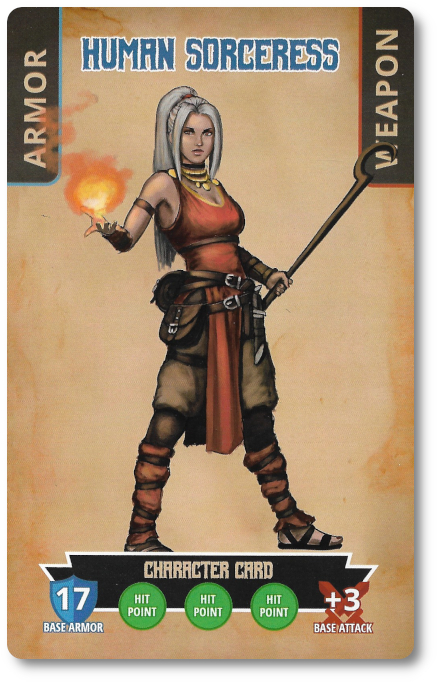
At the bottom of each Character card is the character’s base Armor Class and base Attack bonus. These are used during combat. Between the two values are spots to hold the player’s Health tokens.
Finally, each player is given a unique Special Ability card. These remain in play during the entire game and are considered “equipped” at all times. Special Ability cards provide the player with unique actions or bonuses that can be used during the game per the player’s discretion.
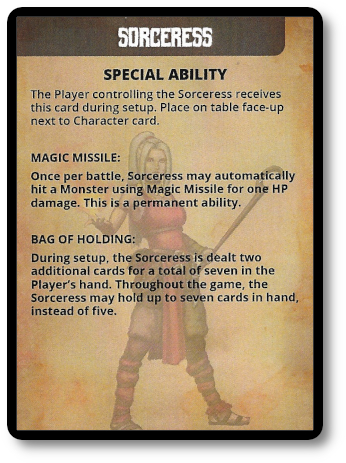
The characters we were provided and their special abilities (excluding the Sorceress shown above) included the following:
- Human Paladin: “Lay On Hands” – heal the player’s character or an opponent’s character
- Human Fighter: “Charge” – bonus to combat
- Dwarf Ranger: “Scouting” – bonus to initiative
- Elf Rogue: “Steal” – steal a card from a player once per game
- Human Monk: “Stunning Fist” – causes a monster to skip its next attack
Yes, Human Sorceress is the best character. Don’t even doubt it.
Let’s Have an Adventure!
RPG Battles is played in rounds and turns with no set number of rounds per game. A player’s turn is summarized here.
Step One: Play a Card
The player may optionally play one or more cards from their hand. This is done by reading it aloud, resolving it by following the instructions, and then placing it face-up in the discard pile.
Possible cards available to the player include forcing an opponent to give cards, shuffling the draw deck, stealing cards from opponents, healing damage, and raising dead characters. Players can also change what weapons and armor they have equipped (but only once per turn).
Each card should be played and resolved one at a time. During the played card’s resolution phase, any opponent can play a card out of turn that would disrupt it. If a card is disrupted, the card played, and the card played against it are placed in the discard pile. The player may continue to play cards during their turn as long as they have cards in their hand.
Step Two: Draw a Card
The player now draws the top-most card from the draw deck, unless a card played during the previous step allows the player to skip drawing from the deck or changes how the player draws cards from the deck.
If the card is anything other than a Trap or Monster, it goes into the player’s hand to be played during their next turn or as an interrupt during an opponent’s turn.
If the card is a Trap or a Monster, the player must resolve the trap and battle the monster to the death. Alternatively, they can attempt to avoid both.
As the game progresses, the draw deck will dwindle. When there are no more cards left to draw, shuffle the discard pile and place it face-down to create a new draw deck.
Step Three: Discard Cards
The player’s last action on their turn – if their character is still alive – is to discard down to no more than five cards in their hand. Cards to be discarded or be played and resolved (if it makes sense to do so).
Traps and Monsters
Traps in the game, when drawn, must be immediately resolved. If a player draws a combination of cards and draws both Traps and Monster cards, traps are always resolved first. Traps are resolved by reading the card’s text and following its instructions. Traps can damage the player as well as their opponents.
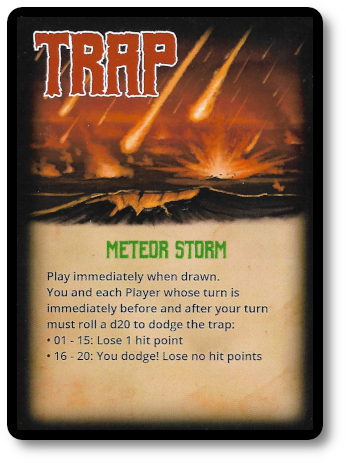
Monsters are a bit more complicated as their card require resolution through combat. By default, the player who drew the Monster card must fight the monster, with an opponent taking control of the monster dice rolls. The player and the opponent roll a 20-sided die to determine initiative, with the player rolling the higher number value going first. The one exception to this is if the player’s character has an equipped weapon or another card that allows for ranged combat. If such is the case, they go first.
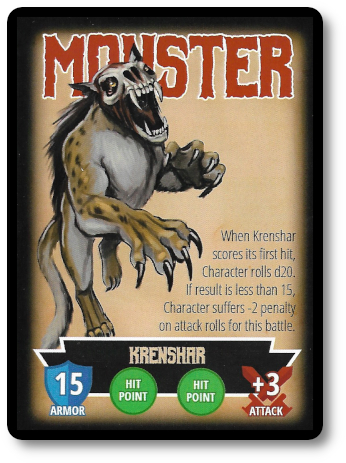
Going in turn order between player and monster, each will attempt an attack. This is done by rolling the 20-sided die, adding the character’s or monster’s Base Attack value, and any Weapon modifiers if applicable. The resulting number value is the player’s total Attack. The Attack number is compared to the target’s Armor Class (AC).
The player hits their target if the Attack value is equal to or greater than the Armor Class value. This results in the target removing one Health token. The one exception to the amount of damage dealt is if the attacker rolls a “Critical Hit” which only happens if the player rolls a “20” on the 20-sided dice. This attack cannot be blocked and inflicts double the damage resulting in the target removing two Health tokens.
During combat, the player can play cards from their hand that will improve their odds of surviving. This is also allowed by the player’s opponents, who could make things worse or react to any player’s cards. Played cards are resolved before the battle continues. This includes cards that allow for multiple attacks, wherein each attack is resolved separately as normal.
A common approach to avoiding combat is to teleport. The monster immediately turns its attention to another player (as described on the Teleport card). When a new player is brought into combat, the initiative is re-rolled to determine the order. Monsters do not heal health if they switch targets.
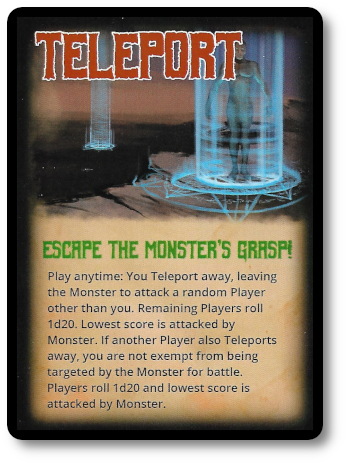
Combat continues until either the player’s character perishes, the monster is slain, or the monster is somehow banished.
Character Death and Resurrection
As the game progresses, the player’s Character will take damage. This is tracked by removing Health tokens from the Character card. The player can play cards that heal their character, but if their Character’s health is reduced to zero, the Character perishes. The player is now out of the game and has lost.
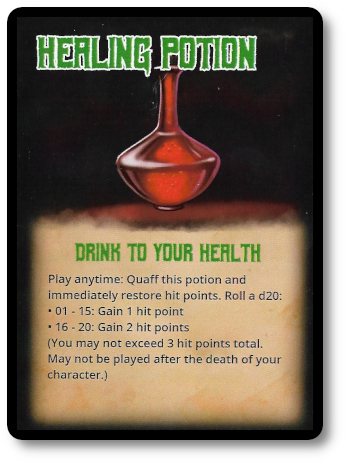
However, in this game, death is not necessarily the end. If the player has the “Rais Dead” card in their hand, their Character avoids death but at the cost of losing all their cards.
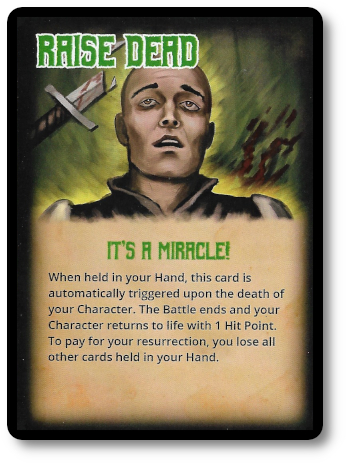
Victory!
The game continues until only one player is left standing. Because they are the only character to survive, they are the winner. If a Trap does damage to multiple players that kill all the remaining in-play Characters at the same time, each player rolls a 20-sided die to determine the winner.
To learn more about RPG Battles: The Card game, visit the game’s website.
Final Word
 The Child Geeks had a great time playing RPG Battles. For those who were also familiar with role-playing games, the game took on additional depth and meaning during their time at the table. According to one Child Geek, “This game is a lot of fun and takes everything I like about role-playing and makes it easy to play with my friends. I don’t have to worry about a story or names or places. Just hack and slash and looting!” Another Child Geek said, “I don’t know how to play role-playing games, but if it is anything like this, I am going to really like it.” When the last bit of gold was grasped, and the final monster is slain, the Child Geeks gave RPG Battles their full approval.
The Child Geeks had a great time playing RPG Battles. For those who were also familiar with role-playing games, the game took on additional depth and meaning during their time at the table. According to one Child Geek, “This game is a lot of fun and takes everything I like about role-playing and makes it easy to play with my friends. I don’t have to worry about a story or names or places. Just hack and slash and looting!” Another Child Geek said, “I don’t know how to play role-playing games, but if it is anything like this, I am going to really like it.” When the last bit of gold was grasped, and the final monster is slain, the Child Geeks gave RPG Battles their full approval.
 The Parent Geeks also enjoyed the game, finding it fun to play with their family and a great excuse to talk about old role-playing game sessions. According to one Parent Geek, “The game is simple and removes any of the stories and character advancement I know I love, but that’s OK. The game is still fun and let us play a game that reminded us so much of our beloved role-playing sessions. I drank way too much soda then. Way too much.” Another Parent Geek said, “It is the geekiest thing in the world to role-play, and I know people look at you differently when you share your hobby. This game, though, it brought everyone to the table. It didn’t matter if you were a role-player, dice-chucker, or newb. We all had a great time.” With the last die rolled, the Parent Geeks awarded RPG Battles a critical hit.
The Parent Geeks also enjoyed the game, finding it fun to play with their family and a great excuse to talk about old role-playing game sessions. According to one Parent Geek, “The game is simple and removes any of the stories and character advancement I know I love, but that’s OK. The game is still fun and let us play a game that reminded us so much of our beloved role-playing sessions. I drank way too much soda then. Way too much.” Another Parent Geek said, “It is the geekiest thing in the world to role-play, and I know people look at you differently when you share your hobby. This game, though, it brought everyone to the table. It didn’t matter if you were a role-player, dice-chucker, or newb. We all had a great time.” With the last die rolled, the Parent Geeks awarded RPG Battles a critical hit.
 The Gamer Geeks gave RPG Battles “mad props” for being based on their beloved role-playing games, but didn’t think the game was all that great. According to one Gamer Geek, “The developers succeeded in taking the hack and slash, putting it into a pretty quick card game. Unfortunately, I’m not 10-years-old, and my mind craves more than drawing a card, rolling a die, and ending my turn. Good game for the younger and more casual player, but the game never got my attention.” Another Gamer Geek said, “The game took the mechanics of a role-playing game and left what makes a role-playing game interesting out of its design. Strange approach. The first game let me stroll down memory lane, but the second game felt like a crawl through the glass. Just not fun for me.” The Gamer Geeks rejected RPG Battles, finding it missed its saving throw.
The Gamer Geeks gave RPG Battles “mad props” for being based on their beloved role-playing games, but didn’t think the game was all that great. According to one Gamer Geek, “The developers succeeded in taking the hack and slash, putting it into a pretty quick card game. Unfortunately, I’m not 10-years-old, and my mind craves more than drawing a card, rolling a die, and ending my turn. Good game for the younger and more casual player, but the game never got my attention.” Another Gamer Geek said, “The game took the mechanics of a role-playing game and left what makes a role-playing game interesting out of its design. Strange approach. The first game let me stroll down memory lane, but the second game felt like a crawl through the glass. Just not fun for me.” The Gamer Geeks rejected RPG Battles, finding it missed its saving throw.
 RPG Battles reminds me of my earliest attempts to play role-playing games with my friends. We’d spend hours hiding from girls pouring over monster manuals, player handbooks, maps, and treasure tables. The rules were way too extensive for us to fully absorbed, so we learned the basics and had a blast dungeon diving and killing skeletons by the thousands. Later, we would learn the creative art of storytelling, which made the game mechanics and math a means to resolve conflicts, wherein the story kept our interest. RPG Battles is just that. It’s the guts of the game, without any story to hook you in or be a part of other than what you choose to tell yourself.
RPG Battles reminds me of my earliest attempts to play role-playing games with my friends. We’d spend hours hiding from girls pouring over monster manuals, player handbooks, maps, and treasure tables. The rules were way too extensive for us to fully absorbed, so we learned the basics and had a blast dungeon diving and killing skeletons by the thousands. Later, we would learn the creative art of storytelling, which made the game mechanics and math a means to resolve conflicts, wherein the story kept our interest. RPG Battles is just that. It’s the guts of the game, without any story to hook you in or be a part of other than what you choose to tell yourself.
Which is good.
What you get in this game is the need for creative hand management and opponent backstabbing. That was enough to keep my interest, but I think the gameplay wasn’t as interesting as it could be due to each player being out for themselves. There is nothing grander than taking out a big enemy with friends. In RPG Battles, the monsters are bad news, but your opponents are even worse. There really isn’t any reason why you are in the game playing it per your character’s point of view other than just trying to kill your fellow adventurers.
Which is bad.
Why? For starters, the game positions itself as a “role-playing game” (that’s what RPG stands for, in case you were still scratching your head about it). Yes, there are battles, but combat is not role-playing. I know why they titled the game as such. The game is full to the brim with fantasy monsters and heroes. The game’s title makes perfect sense in this context. But it’s also misleading. There is no character development, no leveling up, no mystery to solve, or story to tell. It’s just you, a weapon, and a lot of hitting.
Which is neither good nor bad. So we are back to being neutral.
RPG Battles: The Card Game is not intended for those who know the exact number of hit dice of every monster since Second Edition or for those who know the difference between “roll” and “role” whilst playing as a group. RPG Battles is based on and takes inspiration from our beloved role-playing games, but is not a role-playing game by any definition. I know this might read like I am laboring the point, but it’s an important one to make. RPG Battles is a wonderful introduction to role-playing game resolution mechanics and getting into the spirit of fantasy adventure. You can easily wrap a story ahead of the game, tell a story while playing it, and ask the winner to write the ending. Good stuff.
The game isn’t trying to be anything other than itself, in my opinion. It wants its players to smack the bejesus out of monsters and the player’s opponents. It’s your classic old-school arena combat with unique characters that give each player a different take on how to stab, jab, dodge, and duck (with no discernable penalties per class or race). Everyone has the same goal, but the different characters make it interesting.
If you had enjoyed role-playing games when you were a kid, wherein a story wasn’t as important as saving the princess and the gold, then do sit down for a game or two of RPG Battles: The Card Game. It isn’t watered down so much as distilled. No fluff and no mess, other than the guts and blood continually spilled in the game.
This is a paid-for review of the game’s final prototype. Although our time and focus were financially compensated, our words are our own. We’d need at least 10 million dollars before we started saying what other people wanted. Such is the statuesque and legendary integrity of Father Geek, which cannot be bought except by those who own their private islands and small countries.



